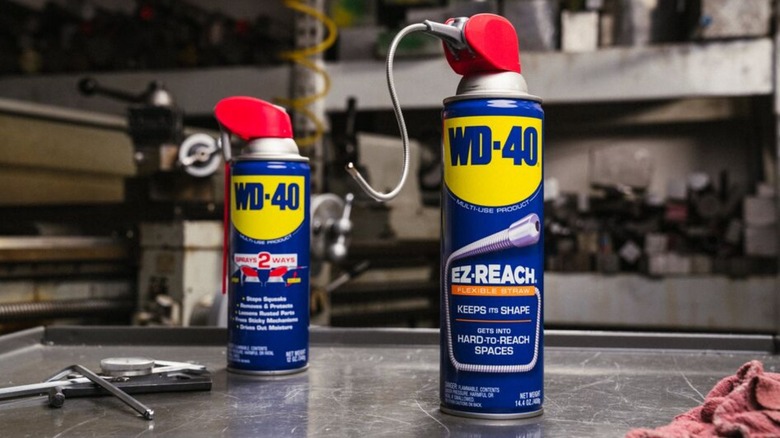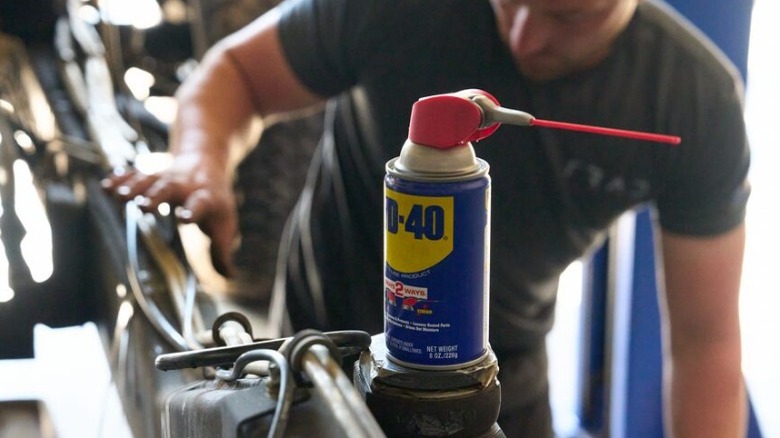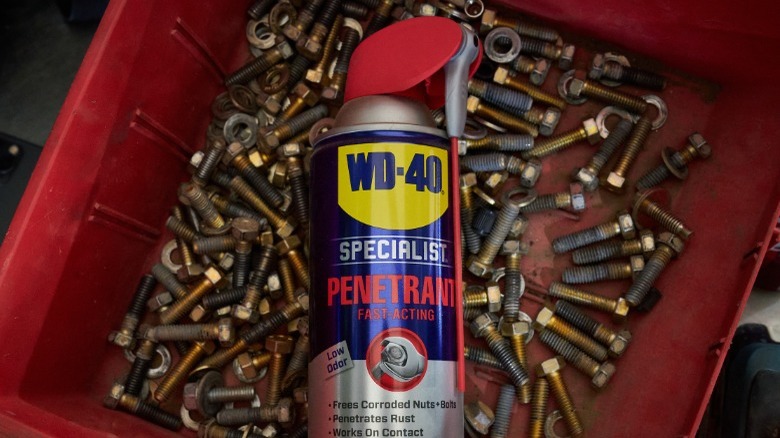6 Potential WD-40 Health Risks & What To Do If You Experience Them
We may receive a commission on purchases made from links.
WD-40 is an extremely versatile product. There are plenty of uses for it around your home and garage. You can use it to lubricate hinges, degrease dirty automotive parts, protect metal from oxidation, and break down rust. It's so handy that most people consider it a staple in their home maintenance kits, but it might be worth taking a look at the effect that this chemical formula can have on the human body.
WD-40 is generally safe enough that most people feel comfortable having a can of it lying around the house somewhere, but there are health risks associated with it that you might want to know about. These aren't secrets. WD-40's Safety Data Sheet (PDF) acknowledges these safety concerns and provides best practices that its customers should follow in order to use its products safely. Here are a few of the more prominent health risks associated with WD-40 and what you should do in the event you experience them.
WD-40 fumes can cause drowsiness and dizziness
Anyone who has ever used WD-40 knows that it has a very distinctive odor, but did you know that the fumes have been known to cause drowsiness and dizziness? According to the manufacturer, standard multi-use WD-40 is safe to use without breathing protection, so long as you're in a well-ventilated area. So you should be fine using it outdoors, as long as you have no related allergies or pre-existing breathing conditions.
That said, there are a lot of applications for the product that tend to involve bringing the can inside. A quick burst in a door hinge probably wouldn't be enough to cause an issue for most people, but you should definitely be aware of this when using large amounts of the spray in a confined space with minimal airflow. Soaking tools in WD-40 to remove rust or using copious amounts on automotive parts as a degreaser are good examples of times when keeping the garage door open might be a good idea. Symptoms of overexposure include: "nasal and respiratory irritation and central nervous system effects such as headache, dizziness, and nausea."
WD-40 suggests that it's best to avoid breathing any vapors or mists when possible. If you experience any of these symptoms, WD-40 recommends that you first move to fresh air and then seek medical attention if breathing irritation develops or your other symptoms persist.
Ingesting WD-40 is toxic
The exact chemical composition of WD-40 is a carefully guarded trade secret, but a majority of the formula is roughly 25% petroleum base oil, 2-3% Carbon Dioxide, and 50-70% aliphatic hydrocarbon. Petroleum-based oil is essentially mineral oil, which is fairly harmless. It's often used to condition wooden cutting boards and other utensils used in the preparation of food. The carbon dioxide is primarily used to pressurize the can. There are some safety concerns associated with this, but not so much related to physical contact. The bigger source of concern is the aliphatic hydrocarbon. Without getting too deep into the chemistry, this compound is a petroleum distillate. You can find it in lots of household products, but it's poisonous–especially when it's consumed by children.
According to "Fundamentals of Toxicology" by P.K. Gupta, (via Science Direct), "It is reported that every year, nearly 28,000 children younger than age 5 years ingest petroleum distillates, accounting for 12–25% deaths due to all poisons in this age group."
So it's definitely a good idea to keep your WD-40 somewhere that small children won't be able to access. That said, the Safety Data Sheet says you should not induce vomiting in the event that the compound is ingested, as this can be an aspiration risk that can lead to choking. Instead, you should call a physician or poison control center immediately and request further instruction.
WD-40 can irritate the skin
WD-40 is at its most dangerous when it's ingested, but it can also be an irritant when you get it on your skin. This means that you should be very careful to make sure that you're directing the nozzle away from you when you are using the spray.
Many of us have gotten a little WD-40 on our hands before and thought nothing of it, but some people might have an adverse reaction when the chemical makes prolonged contact with their skin. The Safety Data Sheet states that this can present as "mild irritation and defatting with possible dermatitis." That isn't the most dangerous thing in the world, but most people would probably agree that it's still best avoided.
The Data Sheet recommends using chemical-resistant gloves when you're using WD-40 in a situation where skin contact seems likely, such as when you're scrubbing rust or grease from metal with a bit of steel wool. It also says that you should wash any exposed parts of the body with soap and water shortly after contact. This will likely be enough to remove the source of the irritation from your skin. The guidelines state that you should seek medical attention if your symptoms persist.
WD-40 can damage your eyes
After learning that it can irritate your skin, it's probably not all that surprising to learn that WD-40 can also be harmful if it manages to get in your eyes. WD-40 acknowledges that direct contact with the eyes can result in irritation, redness, and tearing. This is why the Data Sheet mandates wearing eye protection in applications where eye contact is possible, and always being sure to spray the solvent away from your face.
That said, accidents happen. In the event that some of it does get in your eyes, the Safety Data Sheet says to thoroughly flush out the affected eye with water. There are also special guidelines for people who wear contact lenses. "Remove contact lenses if present after the first 5 minutes and continue flushing for several more minutes." It then instructs you to get medical attention if the irritation continues. This is definitely a good one to know ahead of time, since it's difficult to read safety guidelines right after macing yourself.
WD-40 is flammable
Now that we're past the more direct ways that WD-40 can be hazardous, let's talk about the environmental hazards that it can cause. WD-40 is a highly flammable substance, especially when it first leaves the aerosol can. The compound itself is flammable, so you definitely don't want to leave residue on an engine, exhaust system, or any other component that might get excessively hot or be exposed to an open flame. However, the aerated spray from the aerosol is even more combustible. To prevent combustion, the Safety Data Sheet instructs users to "Keep away from heat, hot surfaces, sparks, open flames, and other ignition sources." It also says that you shouldn't smoke while using WD-40, or use it near any other potential sources of ignition. This includes power tools and motors which may produce sparks while in use.
Since WD-40 is oil-based, you don't want to spray a fire started by it with water. Instead, you want to treat it like a grease fire. "Use water fog, dry chemical, carbon dioxide or foam," the Data Sheet says. "Do not use water jet or flooding amounts of water. Burning product will float on the surface and spread fire"
WD-40 cans can burst
The flammable nature of WD-40 isn't just a problem outside the can, either. WD-40 containers aren't any more impact-resistant than your typical aerosol can, and those that are pierced, burned, or otherwise exposed to extreme heat can explode. This can cause fires, burn the user, and may even turn the can itself into a dangerous projectile.
This can happen when flames on the sprayed surface lead back to the WD-40 can as well. "Vapors are heavier than air and may travel along surfaces to remote ignition sources and flashback," the Data Sheet says. Aside from the explosive nature of the contents release, this can also lead to serious chemical fallout. "Combustion will produce oxides of carbon and hydrocarbons."
To prevent this from happening, WD-40 has detailed instructions for safe storage and handling. In addition to the standard rules about keeping the can away from potential heat and ignition sources, users should avoid contact with sources of electricity as well. "Unplug electrical tools, motors, and appliances before spraying or bringing the can near any source of electricity. Electricity can burn a hole in the can and cause contents to burst into flames. To avoid serious burn injury, do not let the can touch battery terminals, electrical connections on motors or appliances, or any other source of electricity." These guidelines state that you should keep the can in a cool and well-ventilated area that isn't exposed to direct sunlight or anything that may cause it to reach a temperature of over 120 degrees Fahrenheit.






